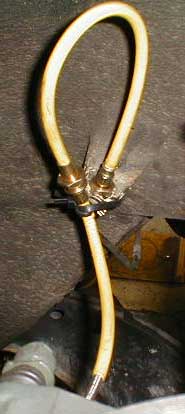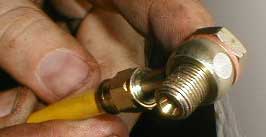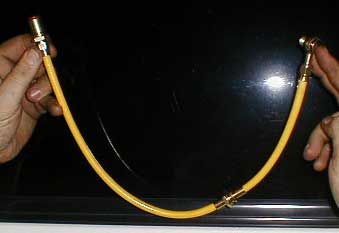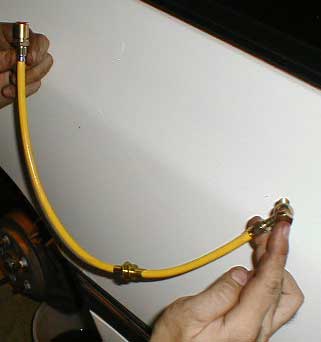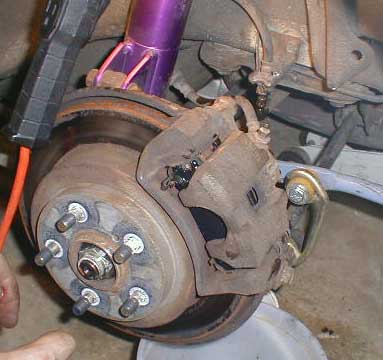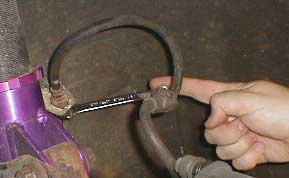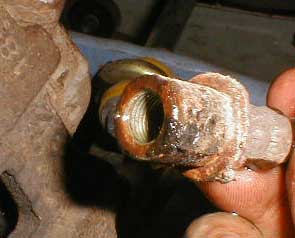|
SMC Stainless Steel Brake Lines By Dave Brakes are one of my nitpicky things. If i test drive a car and the brakes are good, i'm more likely to recommend a car. If the braking is sluggish and mediocre, it makes the car feel inadequete and less capable of being safe. I recently upgraded my front brakes to those found on the newer Legacy, Outback and WRX. While the brakes are much more effective, the feel is the same. Mushy, in a word. I was able to come into possesion of a set of SMC stainless steel brake lines for a very good price via a fellow Legacy owner on the i-club. How it works Braking is essentially based on the concept of hydraulics in modern vehicles, with vacuum assist being an even newer technology and frequently referred to as power brakes. Hydraulic systems are, well, cool. Exerting an amount of force on one part of the system enables equal force to be exerted anywhere else in the system without noticeable loss in force, if the system is designed properly. In the average brake system of a modern car, all the lines going from the master cylinder to either the ABS system or the wheels is aluminum. Only the very last portion of the system, usually going from somewhere in the wheel well to the brake caliper, is rubber or silicone. This is where that mushiness comes from. As the system exerts hydraulic pressure throughout, via the brake fluid, those rubber hoses flex slightly and give up a bit of the overall exerted force made by the system. This is that mushy feel. Stainless steel lines aren't made of steel, instead they're either rubber or silicone hose wrapped in a braid of stainless steel to keep them from flexing outward. This maintains a good deal of the flexibility needed to allow the brake assembly to move up around, but keeps the line from bulging. This transfers the force more directly to the brakes themselves. The result is a more effective braking system and very solid feeling brakes. Removal Make sure everything is sufficiently cool to work on, brakes get hot, burns suck. Remove the wheel and make sure the car is well supported via a sturdy floor jack and/or jackstands. Here's where you'll need a special tool to do the job right. While not a unique tool, the flare-nut wrench is not commonly used elsewhere on automobiles. Basically a flare-nut wrench is a box wrench with a notch cut out of the top so it can be inserted around a line. The wrench touches all six sides of the nut and prevent stripping of the relatively soft, and frequently tight, nuts found in braking and hydraulic systems. I admit i didn't know about this tool till i got frustrated using a standard 10mm open-ended wrench and nearly stripped the nut. A pair of vise-grips helped me get the nut off and back on tight, but the flare-nut wrench (which should be available at any parts store) made the job a piece of cake on the other 3 corners. Buy one 10mm. The clip holding the connection to the bracket shouldn't be removed until the nut has been loosened, otherwise you'll have to use an open 17mm wrench to keep the top from rotating while loosening the bottom fitting. After loosening the fitting, don't remove it. It will drip slightly, so make sure you have something to catch the fluid from making a mess. Remove the line from the strut, if applicable, then take out the nut on the caliper side. Disconnect it completely and remove the fender side to take the line completely out. None of these parts will be used for the new install. Installation Install is basically the reverse of removal, though there might be a few small differences. Due to the steel braiding, the lines won't be quite as flexible as the old ones. The fitting on the fender side should be put almost completely on, then the caliper side should be bolted in as well as possible. The hose may be resistant, and it's not completely necessary to install it in the same orientation as it was before. When you've found an acceptable route, tighten everything good. Remember, hydraulic pressure exerts a lot of force, so any leaks are very, very bad. My lines were wanting to get in the way of the tires, once installed, so i just used some strategically placed zip ties to keep them back behind the angle of the struts. It gives enough room for the line to flex, but keeps them from rubbing against the tire and wheel. Impressions The SMC lines are very nice, with a layer of colored teflon over the braiding and a clear coat over that. The connectors are high-quality and very strong. There are all new caliper attachment bolts and washers included. After bleeding the system extensively, we took it out for a test drive. Immediately i noticed an absence of the sloppiness i'd felt for a long time. After the initial travel, the pedal simply goes hard, and the car begins decelerating fast. It took a few tries to modulate it better, but my initial impressions are excellent. The feel is very solid, very direct and i am very pleased with the improvement in feel over the old system. In all, the job isn't very hard if done right and with patience. I hightly recommend SS brakelines to anyone interested in better performance and feel out of their brake system. Images:
|

